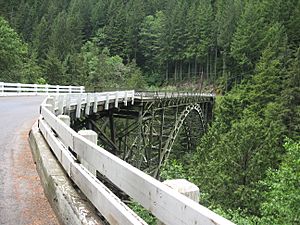Fairfax Bridge (Washington) facts for kids
Quick facts for kids Fairfax Bridge |
|
|---|---|
 |
|
| Crosses | |
| Locale | Melmont, Washington |
| Other name(s) | O'Farrell Bridge |
| Heritage status | NRHP |
| Characteristics | |
| Design | Three-hinged arch |
| Material | Steel |
| Clearance below | 250 feet (76 m) |
| History | |
| Construction end | 1921 |
| Construction cost | $80,000 |
|
Fairfax Bridge
|
|
 |
|
| MPS | Historic Bridges/Tunnels in Washington State TR |
| NRHP reference No. | 82004273 |
| Added to NRHP | July 16, 1982 |
The Fairfax Bridge (also called the O'Farrell Bridge) is a cool steel bridge in Pierce County, Washington. It crosses the Carbon River and is part of State Route 165. This bridge was built in 1921 and cost about $80,000. It's very tall, with its deck sitting 250 feet (76 meters) above the river!
The Fairfax Bridge was added to the National Register of Historic Places in 1982. This means it's an important historical site.
A Lifeline for Fairfax
Before the Fairfax Bridge was built, reaching the town of Fairfax was quite a challenge. People mostly relied on a train that only came twice a day. The only other way was to walk to a nearby town called Melmont. From there, a wagon road connected to other places.
The bridge changed everything for Fairfax. It created the first real road into the town. This made it much easier for people and goods to travel. At the time, it was even thought to be the highest bridge in the state!
How the Bridge Was Built
The Fairfax Bridge is a special type of bridge called a three-hinged arch bridge. It's made of strong steel. The whole bridge is 494 feet (151 meters) long.
The main part of the bridge is a 240-foot (73-meter) steel arch. This arch has three "hinges" that help it handle movement and changes in temperature. There are also two steel towers and 16 wooden sections leading up to the main arch.
The steel parts of the bridge were made by the Minneapolis Steel and Machinery Company. The arches rest on strong concrete bases. Later, in 1945, parts of the bridge, like the roadway, were rebuilt to keep it safe and strong.
Why This Design?
The Fairfax Bridge is one of only two three-hinged arch bridges left in Washington state. You might wonder why this type of bridge isn't more common.
Engineers in Europe often used arch bridges because they looked nice. They were also inspired by old stone arch bridges. In America, engineers often chose simpler bridge designs. They thought these were easier to build and cost less money.
However, arch bridges are great for certain places. They work very well for deep canyons with rocky sides. The Carbon River canyon was perfect for an arch bridge. Its deep shape made this type of bridge a good and strong choice.
Images for kids



